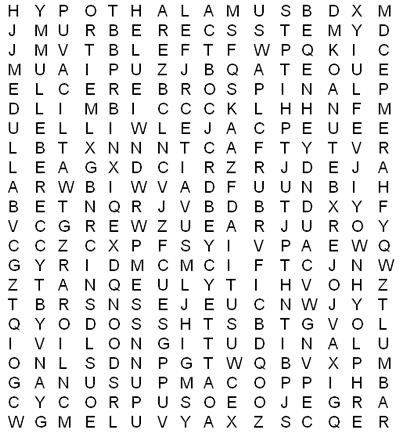Central Nervous System Review
1. The worm-like ridges on the surface of the brain are called _ gyri _
2. The thin, web-like membrane between the outer and inner layer of meninges is called the __ arachnoid __ mater.
3. The right side of your brain controls the _ left _side of your body
4. The _ lumbar ___enlargement of the spinal cord supplies nerves to the lower limbs, whereas the __ cervical ________ enlargement supplies nerves to the shoulders and arms.
5. The innermost layer of meninges that supplies blood vessels to the brain called the ___ pia ____ mater.
6. The ______ longitudinal ___ fissure separates the two hemispheres
7. ___ descending ____tracts within the spinal cord carry motor impulses to the muscles.
8. The _____ corpus callosum _____ connects the two hemispheres of the brain.
9. The __ cerebrum ___ is the major part of the brain that controls higher mental activities, such as learning and making decisions.
10. The ___ cerebellum _ is the part of the brain that controls the coordination, balance and equilibrium.
11. ___ ascending ___tracts within the spinal cord carry sensory impulses to the brain.
12. The outermost of the three meninges is the __ dura ___ mater.
13. The fluid filled cavities within our brains are called _ ventricles.
14. The brain and spinal cord are surrounded (and float within) cerebrospinal fluid.
15. The brain ___ stem ___ consists of the midbrain, pons, and medulla oblongata.
16. The _____ limbic _______ system controls emotional experiences.
17. The ____ medulla ______ oblongata is responsible for regulation of the body, such as heart rate, body temperature and blood pressure.
18. The part of the brain that plays a major role in memory is the ______ hippocampus _______
19. The master gland of the endocrine system dealing with hormones is the ___ pituitary ___ gland
20. Part of the diencephalon, controls basic functions such as body temperature, and hunger: _____ hypothalamus _____

First Diagram: A- meninges, B – diencephalon, C – Midbrain, D – Pons, E – Medulla, AB – Brain Stem, AD – corpus callosum, AE- cerebellum
Lobes: A – frontal, B – parietal, C – occipital, D – temporal, E – cerebellum (not a lobe)